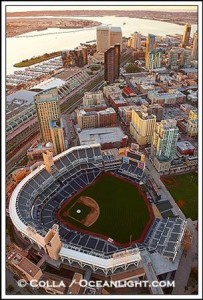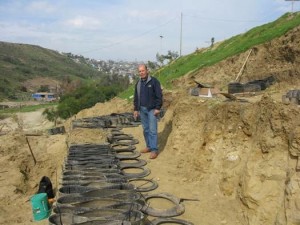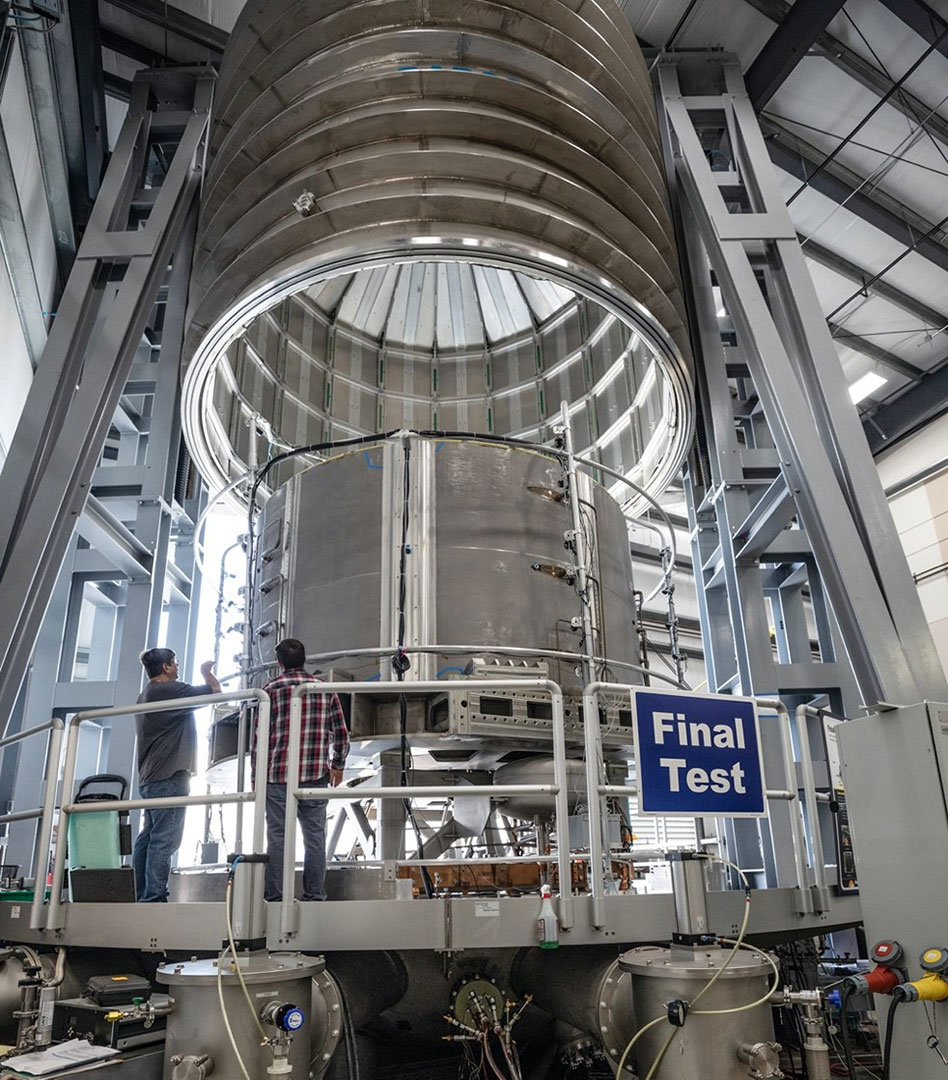Daily Business Report — May 17, 2010
40 Under 40 Nominations
Nominations are now open for San Diego Metropolitan Magazine’s 11th annual 40 Under 40 awards. The nomination period ends May 31. The honorees will be feted at our annual luncheon on Sept. 9 at the San Diego Convention Center and profiled in the September issue of the magazine. Visit http://sandiegometro.com/40under40/ for a nomination form.
‘Best of the Decade’ Smart Growth Awards
The San Diego/Tijuana district council of the Urban Land Institute revealed its “Best of the Decade” Smart Growth Awards during its seventh annual awards program last week. Each of the six winners received a hand-crafted trophy by artisans at Basile Studio. The winners are described at the end of this column.
Robinson Appointed to Regional Airport Authority Board
Paul Robinson, 63, of San Diego, has been appointed to the San Diego County Regional Airport Authority governing board. Since 1982, he has served as partner for Hecht Solberg Robinson Goldberg and Bagley, where he was also an associate from 1980 to 1982. Previously, Robinson was assistant to Mayor Pete Wilson from 1978 to 1980 and deputy city attorney for San Diego from 1973 to 1978. He is a member of the real Ppoperty and public law sections of the California State Bar and the real estate and land use sections of the San Diego County Bar Association. The position does not require Senate confirmation and there is no salary. Robinson is a Republican.
Chinese Citizen Convicted of Attempted Export of Defense Material
A federal grand jury in San Diego has convicted a Chinese citizen of offenses relating to his efforts to illegally obtain defense articles on the U.S. Munitions List and have them exported to Macau and Hong Kong. The jury convicted Chi Tong Kuok of four counts of conspiracy to export defense articles without a license and smuggle goods from the United States, smuggling goods from the United States, attempting to export defense articles without a license and money laundering. The articles consisted generally of communications, encryption and global positioning system equipment used by the United States and NATO militaries. Federal law prohibits the exportation of such items without a license from the United States Department of State.
According to evidence presented at trial and court documents, in late 2006, Kuok contacted a company in the United Kingdom, seeking to obtain various components related to the VDC-300 data controller, a device manufactured and sold by Viasat,Inc., a defense contractor based in Carlsbad. The controller is used by the U.S. and NATO militaries to route communications data to and from tactical radios. The U.K. company referred Kuok to an undercover agent with U.S. Immigration and Customs Enforcement. The undercover agent subsequently negotiated with Kuok for over two years, mainly through e-mails, as Kuok sought to obtain the VDC-300 peripherals, an AN/CYZ-10, and a PSN-13, among other items. The CYZ-10 is a portable fill or data transfer device used by the U.S. and NATO militaries to load encryption software into communication devices, such as tactical radios. The encryption software, in turn, allows the radios to communicate securely. The PSN-13 is a GPS device, also used by the U.S. and NATO militaries.
During the over two years that Kuok negotiated with the undercover agent, he also sought to obtain the same and other items from individuals in Los Angeles; Hanover, Mass.; and Phoenix.
High-Speed Rail System Conference Set for June 17-18
Leaders from the U. High Speed Rail Association legislators, and other business and civic leaders from throughout California will gather in Los Angeles on June 17-18 to discuss the future of the nation’s high-speed rail system. The association is hosting High Speed Rail 2010 to give state business leaders a closer look at plans, processes, pathways and potential for a high speed rail system in California and other parts of the U.S. The conference will be held from 8 a.m. to 6 p.m. on June 17 and from 8:30 a.m. to 5 p.m. on June 18 at the Hilton Universal City, 555 Universal Terrace Parkway, in Universal City.
In 2009, President Obama announced the allotment of $8 billion in federal funds to develop HSR projects across the nation, and made $2.3 billion available for California earlier this year. The state, through the California High Speed Rail Authority, has ambitious plans to develop a system connecting the Bay Area with San Diego. The first phase, at an estimated cost of $43 billion, would connect Los Angeles and Anaheim to San Francisco by 2020.
Local Dietitian Honored for Work with Childhood Obesity Prevention
Joanne Drinkwater, dietician for the American Red Cross Women, Infants, and Children (WIC) program, has been recognized by the San Diego County Childhood Obesity Initiative for her commitment to obesity prevention. She has been chosen as the initiative’s “Domain Partner” in recognition of her outstanding achievements in her efforts to prevent and treat childhood obesity in the local community. Drinkwater is leading all five San Diego WIC programs in a project with the American Academy of Pediatrics, California chapter, which seeks to educate health care providers about the new, healthy foods available through WIC and to develop partnerships with the health care community in a mutual effort to eradicate childhood obesity.
About 35 percent of children and teens in San Diego County are overweight, according to the 2007 San Diego County Report Card on Children and Families. The rate of overweight children in San Diego has doubled since the 1970s. Nationwide, this is the first generation of children in recorded history that is not expected to outlive its parents.
INDUS CEO to Receive NDIA Executive of the Year Award
James Lasswell, president and CEO of INDUS, will receive the Sridhar Small Business Executive of the Year Award May 26 from the National Defense Industrial Association (NDIA) at its seventh annual Small Business Conference at the Von Braun Center in Huntsville, Ala. The company, which provides communications, engineering, IT and other services to the Department of Defense and other government agencies, has grown an average of 20 percent over the past four years, according to Lasswell. Lasswell is a member of the Armed Forces Communications and Electronics Association and the San Diego Regional Chamber of Commerce. He was recently elected to the San Diego USO board of directors.
The Kathleen P. Sridhar Small Business Executive of the Year Award is named in honor of Dr. Kathleen P. Sridhar, who was a small business CEO. She served as president of the San Diego chapter of NDIA.
Airport Authority CEO Named to Federal Panel on Aviation
Thella F. Bowens, president and CEO of the San Diego County Regional Airport Authority, has been named to a new federal committee on the future of the U.S. aviation industry. The Future of Aviation Advisory Committee will hold its first meeting May 25 in Washington, D.C. U.S. Transportation Secretary Ray LaHood appointed Bowens to the panel. The panel is to provide information, advice and recommendations to La Hood on how to ensure the competitiveness of the aviation industry. Bowens was appointed president and CEO in 2003. Prior to 2003, when the San Diego Unified Port District operated the airport, she was the port’s senior director of aviation for seven years. Before coming to San Diego, Bowens served as deputy executive director of Kansas City’s Aviation Department, which included Kansas City International Airport and the city’s two general aviation airports.
Smart Growth Awards
“Our distinguished jury had a big job this year and spent hours pouring over all of the nominations,” said Frank Wolden, event chairman and master of ceremonies for the Smart Growth Awards gala at Liberty Station’s McMillin Event Center. “But as is the ULI way, we allowed the jury the flexibility to come to their own conclusions about the ever-evolving definition of smart growth and how to best highlight projects and plans that were significant markers along the way. The built-in flexibility also allowed the jury to make sure that social, economic, cultural, and demographic issues were taken into account.”
Smart Growth Awards Winners:
City of San Diego General Plan Update
The city of San Diego General Plan, updated in 2008, provides a long-range vision and comprehensive policy framework for how the City should plan for growth and development, provide public services, address sustainability, and maintain the qualities that define San Diego over the next 20 to 30 years. The Plan’s policies represent a shift in focus from how to develop vacant land to how to design infill development and reinvest in existing communities. The General Plan is the embodiment of smart growth principles, calling for growth to occur in compact, mixed-use centers linked by transit, with ecologically important open spaces preserved. Distinguished by its City of Villages strategy, the plan seeks to respect San Diego’s natural canyon and coastal environment, and its wealth of distinctive neighborhoods. Sustainability principles are incorporated throughout the plan and across disciplines, with policies addressing: climate change, economic prosperity, water conservation, energy efficiency, waste reduction, and sustainable building objective.
The public engagement process was extensive, consisting of televised public forums, direct email to over 2,700 contacts, fact sheets, brochures, surveys, and over 250 public meetings. The result was widespread support and unanimous adoption by the City Council.
San Diego Association of Governments – Regional Comprehensive Plan including the Smart Growth Map
The implementation of a smart growth strategy for the San Diego region requires that many pieces come together, both locally and regionally. When the San Diego Association of Governments (SANDAG) Board adopted the Regional Comprehensive Plan (RCP) in 2004, it established a “blueprint” for a more sustainable San Diego. The early action of the RCP to develop a Smart Growth Concept Map for the San Diego region led to the identification of smart growth opportunity areas in local communities and helped direct regional funding for planning efforts and infrastructure improvements toward these areas. The RCP framework together with the passage of the TransNet sales tax extension in 2004, established a “Smart Growth Incentive Program” providing funds for public infrastructure projects and planning activities that increase housing and transportation choices. SANDAG’s Smart Growth Incentive Program provides an important piece of the puzzle and represents a step toward more and more communities having an opportunity to compete for smarter growth.
Downtown San Diego Community Plan
During the construction of the Ballpark the Downtown San Diego Partnership and the East Village Association realized that in order to embrace the population growth that the City of San Diego had allocated to downtown – 30 percent of the future City total, the Centre City Community Plan had to be revised. Lead by a Steering Committee comprised of stakeholders, downtown was the first community to embrace density and smart growth principles necessary to accommodate a population which potentially will triple to 90,000 residents and double to 160,000 employees by 2030.
The Downtown Community Plan sets forth a vision of mixed use livability that requires public infrastructure such as parks and libraries to be developed in a manner which creates neighborhood focal points and promotes walkability. The Plan sets forth detailed zoning and development standards, park acquisitions and transportation and parking improvements to implement the Smart Growth Vision.
Ballpark District in East Village

Downtown San Diego’s East Village, once the center of industry in the San Diego region, had become one of the region’s most blighted neighborhoods. Over the past decade, major redevelopment efforts centered around the construction of PETCO Park have transformed East Village into one of San Diego’s fastest-growing and most popular neighborhoods.
East Village had long been the hub of the region’s trolley system with four trolley stations and excellent access to three freeways. But, isolated from the bay and dominated by industrial uses it lacked the “heart” or neighborhood center that nearby neighborhoods like Little Italy enjoyed. It needed a “big bang” to jump start reinvestment in the community. Plans for PETCO Park called for “more than a ballpark” and led a massive public/private investment that provided the infrastructure not just for baseball, but for other residential and commercial developments to come.
The Padres and CCDC worked with the community, through the East Village Association and the Downtown San Diego Partnership to update the Centre City Community Plan to allow for a vibrant high density, mixed use neighborhood. Over a decade later, parks and public infrastructure have been built, thousands of new residents have moved in, four new hotels have opened, and mom-and-pop retailers are giving the neighborhood a new soul. The neighborhood’s success is a model for Smart Growth that can be applied in other communities.
Smart Growth Community of the Decade – Little Italy in Downtown San Diego

Little Italy has become one of the most vibrant pedestrian oriented neighborhoods in the San Diego region. Its eclectic blend of architecture and streetlife builds on a rich history of community and ethnic heritage while inviting a diverse pattern of growth and infill into an existing “in city” neighborhood. Smart growth at its best, Little Italy provides an excellent example for other communities in San Diego. With India Street as its centerpiece, the Little Italy BID has skillfully promoted property owner contributions toward community improvements and maintenance, including such things as: sidewalk improvements, special lighting, street cleaning, security, street beautification, marketing, community events, and many more. These activities set the stage for creative developers and architects who have contributed some of San Diego’s most interesting and varied infill developments. Featured among them, the Lind Project set a new standard for infill. Developer/architect teams collaborated in the development of a block that not only addressed the scale and character of the neighborhood but featured a series of smaller buildings by different designers artfully woven into the fabric of Little Italy. Over the past decade the social and architectural expressions of the Lind Project have been significant in evolving the creative spirit of Little Italy as a 21st century urban neighborhood.
South of the Border Award – Community Development and Sustainable Tire Reutilization Project

Residents of various colonias in Los Laureles Canyon, Tijuana, Mexico, use discarded tires to build foundations retaining walls, and other structures for their homes. During the storm season, large numbers of tires dislodge from this improvised structures washing down hills and canyons ending up at undesirable locations in the watershed. As a result, thousands of tires per year are accumulated in the Tijuana River Estuary. Along with the tires, debris and very large sediment loads cross the border north causing destruction of sensitive and pristine habitats like the coastal sage scrub, the riparian and salt marsh communities, and the wetland/upland transition; another impact is that it chokes out valuable tidal channels killing vast numbers of marine species. The cost of removing the tires is extremely high, and has negative political consequences for the border communities. To address these issues, this project takes a sustainable and systematic approach to improve environmental, economic, and social conditions in the San Diego/ Tijuana region.
Currently open space is being protected by providing aesthetically pleasing structures and landscape in the recreational area. In addition water is captured for reforestation and aquifer recharge, the system approach and the use of natural elements reduces environmental impacts on both sides of the border. Through this experience, new legislation and city codes are being developed, furthering smart growth goals by: Minimizing the use and impact on natural resources; promoting social equity; respecting community character, design and historic features
2010 Community Vision Award
In addition to the Smart Growth Awards, the San Diego Architectural Foundation presented its Community Vision Award for 2010 to the Jacobs Center for Neighborhood Innovation, based on the project, The Village at Market Creek. The community will receive a $25,000 grant to make the improvements of its choice. Finalists for the award were the Mission Hills Town Council, based on the project 1Mission, and Little Italy Association, based on the project The Q.
The Daily Business Report is produced by REP Publishing Inc., publisher of San Diego Metropolitan Magazine, the North Park News, Kensington News and the West Coast Craftsman. (619) 906-4104.


